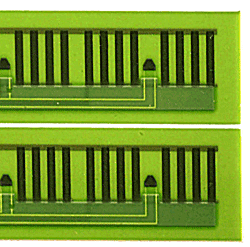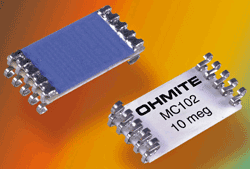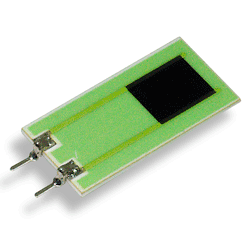Alumina substrate packs in passive components
Proven technology allows resistors and sensors to be printed directly on to a board
BY MIKE WEST
Director of Engineering
Ohmite Manufacturing
www.ohmite.com
Today’s electronic device market is characterized by two conflicting demands: more power, less space. As users come to expect ever more capabilities from ever smaller electronics, electrical engineers are in need of innovative and efficient new solutions for packing more components into shrinking board space. This pressure isn’t limited to iPhones, tablets, and other handheld devices. It’s also being levied on power applications, industrial applications, harsh environment applications, and extreme heat applications.
There is a push to miniaturize all possible aspects of circuitry. Passive components such as resistors and capacitors still consume a majority of board space in most electronic devices. This can quickly become a problem for products that require a large number of resistors, particularly physically larger power resistors.
For applications such as these, alumina substrate technology can offer a great solution. Although the technology has been around for decades, it has enjoyed a renewed popularity in recent years as the use of microcircuits and hybrid microcircuits has increased. Alumina substrate offers excellent heat dissipation and resistors can be printed directly onto the board, saving crucial space (see Fig. 1 ).
Efficient heat dissipation is crucial for reliable and long-lasting performance in high-power applications, and alumina’s high thermal conductivity is ideal for handling the heat. PC boards do not dissipate heat, meaning that more resistors, heat sinks, and other space-consuming components are required to do the work of thermal management.

Fig. 1: Example of resistors printed directly onto the surface of a board.
With PC Boards, chip resistors must also be placed on top on the board, and other components cannot be placed on top of them — taking up significant space. With alumina substrate manufacturers can print resistors directly onto the surface of the board. These resistors are very thin, approximately the same height as the copper conductive traces on a PC board, allowing for efficient use of board space. Manufacturers can also place components directly on top of these resistors while still making conductor traces between them, doubling the space utilization. While components such as transistors and diodes must still be surface mounted on alumina substrate, the space saved on resistors adds up to big benefits for power applications.
The alumina substrate is particularly suitable for temperature regulation in products like irons, coffee cup warmers, hair straighteners, and other heat-intensive items. Temperature sensors can actually be printed directly onto the board, just like the resistors mentioned above, and this reduces space consumption while also ensuring that the sensor can be mounted closer to a heat source for quicker response time. As a result of alumina’s heat dissipation characteristics, the sensor is exposed to a precise, even temperature, and users do not have to worry about error due to hot-spotting or other irregularities.
There are also discreet surface mount resistor products that make use of alumina substrate for improved heat dissipation. One example is Ohmite’s MacroChip resistors with values from 100 Ω to 5,000 MΩ, power rating of 0.75 to 3.25 W, and voltage rating of 2.0 to 10.0 kV. Using thick-film-on-alumina substrate technology, the resistors can be provided in precision tolerances, high voltage ratings, and high resistance values (see Fig. 2 ). The planar package design is low profile for easy implementation.

Fig. 2: The MC102 power resistor uses thick- film- on- alumina substrate for tolerances as low as ±0.5% and a voltage rating of 5 kV.

Fig. 3: TA205 Power Chip resistors feature thick film on alumina substrate technology and high temperature solder and in-process plating that keeps terminations secure.
A second example is the TA205 5-W resistor with a planar package that yields a space saving 10-W/in.2 power density (see Fig. 3 ). This type comes with a tolerance of ±1, ±5, or ±10% and a resistance range of 0.25 Ω to 10 MΩ. ■
Advertisement
Learn more about Ohmite Manufacturing





